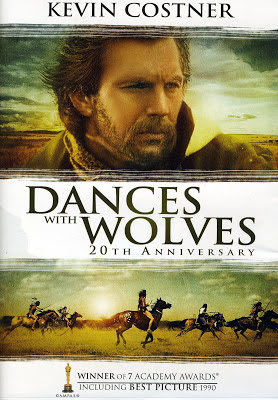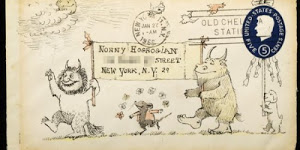Shot almost entirely on location in South Dakota and Wyoming, Dances with Wolves tells the story of a Civil War hero who longs for the frontier, which he can sense will not remain a wild world for long. When he reaches his station, the farthest outpost of the United States Army, he finds it abandoned, and sets in for a long wait of either returning soldiers or a relief unit. Unknown to him, a series of coincidences leave any trace of his existance on the frontier virutally unknown. The rest of the movie documents John Dunbar's work to make contact with the local Lakota (Sioux) Indian tribe, and the growing relationship that come from it.
I want to stress that this is not your daddy's Western, not a Spaghetti from earlier decades. It's a film that reflected people's changing views on Western Manifest Destiny, on American Indians, and ourselves. It was ahead of its time in that the movie is largely in subtitles while the actors all speak in the Lakota language. In fact, it is renown for its portrayal of a people as just that- people. They are not savages, noble or otherwise, but likewise they are not victimized, nor idolized people. They are human, as is the hero John Dunbar. Some may complain that Dances With Wolves is a prime example of the "Guilty White Man Fantasy" where a white man, whose culture is set to essentially erase or assimilate another culture, comes to love and join the threatened culture. It is a storyline that bothers many people due to fact it often feels as if the movie makers felt the audience wouldn't connect with the threatened culture without a white person, but I disagree in the case of Dances with Wolves, or, perhaps, more accurately, I felt that while the movie did fall into this "fantasy," it did so with a greater purpose. One of the large themes is conflict versus understanding. This is present in the Civil War battles, in the conflicts between different Indian tribes and between American Indians and the settlers and the U.S. Army. Certainly what cannot be argued with is the fact that the Lakota tribe was pleased enough with Costner's efforts that he, like the character he portrayed, earned memebership into the tribe.
Overall, I found the story and the acting intensely moving and captivating. Even filtered through subtitles, one is aware of the undercurrents and emotions playing out across the scree. This film also has much more historical accuracy than most westerns you'll encounter! The only thing that kind of bugged me, was the movie's ending was made to be intentionally vague. The story themeatically ends, but the character's ultimate fates remain unknown. Still, for a look at the Indian Wars, and the people who fought those battles, this movie provides an emotional and captivaing first look.






Jim and I just rewatched this movie, I really enjoyed it. The ending was unsettling, but it worked in the sense that you know that none of them made it.....yet you could still hope they would.
Reply DeleteThis was like my favourite movie when I was about 10 years old - or maybe even younger. Still the best Kevin Costner movie to date. : D
Reply Deletehttp://mn2nz.wordpress.com